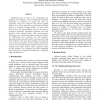Free Online Productivity Tools
i2Speak
i2Symbol
i2OCR
iTex2Img
iWeb2Print
iWeb2Shot
i2Type
iPdf2Split
iPdf2Merge
i2Bopomofo
i2Arabic
i2Style
i2Image
i2PDF
iLatex2Rtf
Sci2ools
HICSS
2006
IEEE
2006
IEEE
Patterns of Multimodal Input Usage in Non-Visual Information Navigation
Multimodal input is known to be advantageous for graphical user interfaces, but its benefits for non-visual interaction are unknown. To explore this issue, an exploratory study was conducted with fourteen sighted subjects on a system that allows speech input and hand input on a touchpad. Findings include: (1) Users chose between these two input modalities based on the types of operations undertaken. Navigation operations were done primarily with touchpad input, while non-navigation instructions were carried out primarily using speech input. (2) Multimodal error correction was not prevalent. Repeating a failed operation until it succeeded and trying other methods in the same input modality were dominant error-correction strategies. (3) The modality learned first was not necessarily the primary modality used later, but a training order effect existed. These empirical results provide guidelines for designing non-visual multimodal input and create a comparison baseline for a subsequent st...
Biometrics | HICSS 2006 | Input | Multimodal Input | Speech Input | System Sciences |
Related Content
| Added | 11 Jun 2010 |
| Updated | 11 Jun 2010 |
| Type | Conference |
| Year | 2006 |
| Where | HICSS |
| Authors | Xiaoyu Chen, Marilyn Tremaine |
Comments (0)

